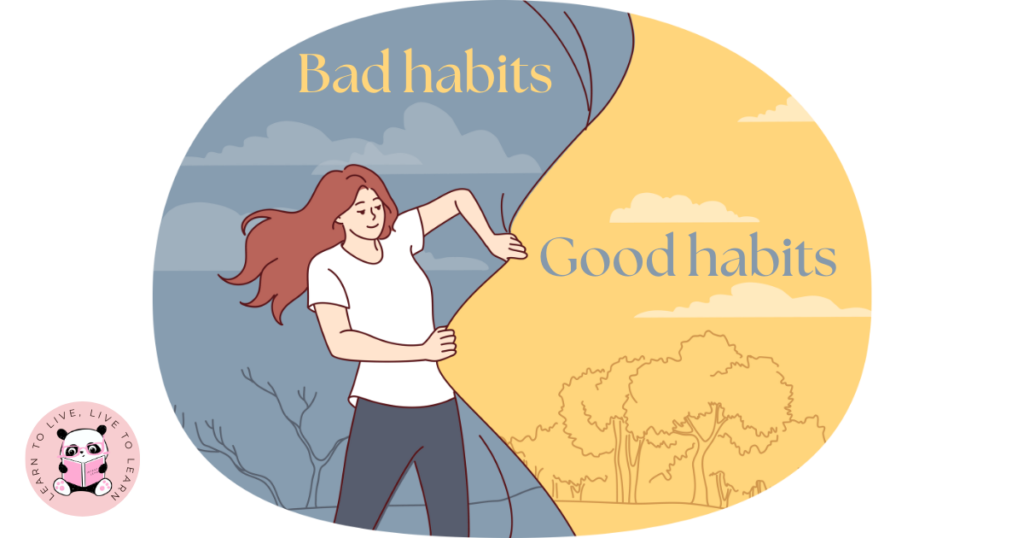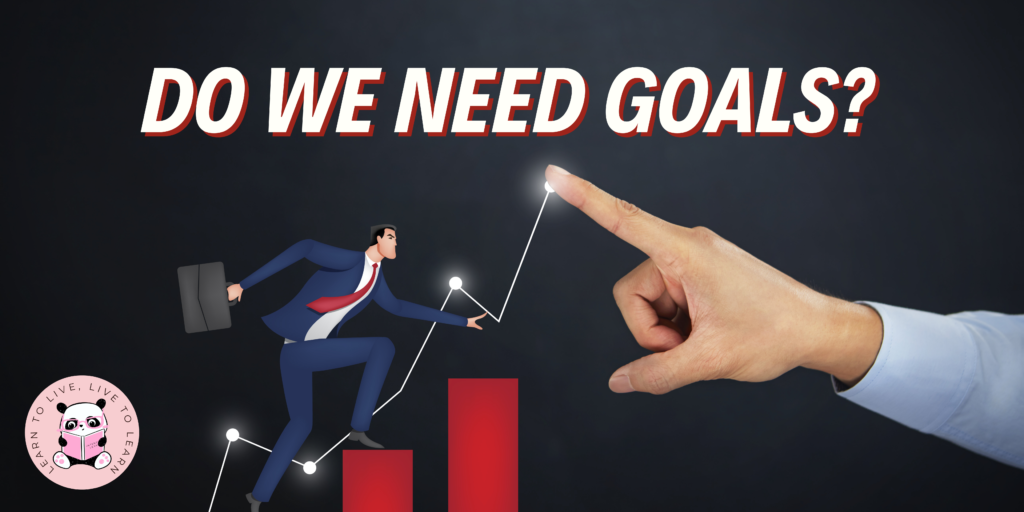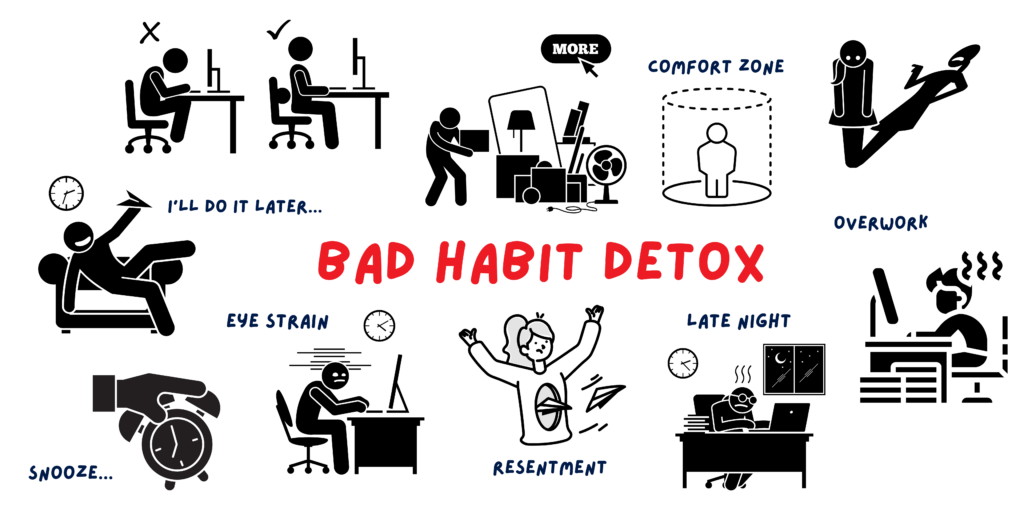Break Any Bad Habit With This Powerful Method
Written by Michelle Ong | April 28, 2024 | Growth, Productivity

Break bad habits and be better than yesterday with the powerful 5 ‘R’s method. Get ready to transform and unlock your full potential.
Overcoming bad habits boosts well-being and sets the stage for success. Recognizing their impact on my life has been crucial, as they can seriously hinder both success and personal growth. I found that acknowledging the problem is the first step toward change—without that awareness, there’s no motivation to improve. It took courage to face these issues, but it was worth it. From my experience with exercising more, reducing binge-watching, and being mindful of my health, I’ve distilled the process into five simple steps—the 5 ‘R’s. Let’s walk through it together.
1. Root Cause Analysis
“Change your thoughts and you change your world.”
Norman Vincent Peale
Understanding why you do the bad habit is the first step towards overcoming it. Think about what triggers it, and why you want to change. Often, even when we know a habit is harmful, we stick to it because we are turned of by the effort it takes to change. That’s why having a strong reason to break the habit is crucial. It helps you see the importance of change and provides you the motivation to make it happen.
When I decided to stop avoiding exercise, I asked myself three questions:
- Why am I avoiding exercise?
- When did I start avoiding it?
- What makes me resist doing it?
I became more self-aware of my habits. I recognized how overeating junk food, binge-watching and a sedentary lifestyle were holding me back. This reframed my perspective on health and rooted my commitment towards fitness.
Consider checking out this post where I put together a list of common habits that hold us back from success.
2. Replace
To effectively get rid of a bad habit, you have to replace it with a good one that serves the same need but in a healthier way. For instance, instead of avoiding exercise, I made it a daily habit. This shift not only met the need the bad habit once filled but also did so in a way that benefits my health.
This is a constructive approach that directs your attention to the new positive habit, making it less likely to fall back into old patterns. It allows gradual progress with small steps reinforcing the new behavior over time, creating a cycle of growth and improvement.
Let’s say you want to quit smoking, pick a healthier behavior that serves the same purpose, like playing a musical instrument like a flute instead. If you often criticize yourself due to low confidence, try focusing on positivity. Consider starting your day with affirmations or encouraging yourself with a simple fist bump. Embracing these small actions can gradually build your self-esteem, fostering personal growth and happiness.
3. Create Routines
“It’s not about perfect. It’s about effort. And when you bring that effort every single day, that’s where transformation happens. That’s how change occurs.”
Jillian Michaels
Once I understood why I was avoiding exercise and recognized the need for a good habit, I felt more mentally ready to stop procrastinating and just get started. I brainstormed ways to break the habit and created a plan to steer me toward my fitness goals, breaking it down into small, manageable steps.
For example, I struggled with cardio workouts like running or jogging because I disliked feeling out of breath, sweaty, and muscle aches. It was much easier to keep putting it off and binge-watching shows instead. Overcoming this fear of hard work was crucial for breaking free from this habit and growing as a person.
My workout plan started with short, easy routines—like 5-minute stretches after getting up, and brisk walking outdoors. I gradually ramped up the intensity, moving to a 1km jog, then longer 5km and even 10km runs, and adding other workouts like swimming, yoga, pilates and Zumba. A note of caution: it’s important not to overdo it when starting from scratch. The process has to be gradual and at your own pace.
When I started, I didn’t have a detailed plan. I committed myself towards 5 minutes of exercise a day, with the bottom line being consistency. On days when I didn’t feel well enough to go outside, I would do light stretching indoors—just to keep my body moving.
The key is to make the plan flexible, adjusting as needed so it’s feasible. It all started with small, consistent efforts and the determination to keep going, no matter what. Now, I can’t imagine my life without these workout routines.
If you would like to create your personal routines, check out this post for tips to help you in planning.
4. Right Cues
Using the right cues can nudge us toward better habits. To break bad habits, I focused on making them harder to do while encouraging good ones. I identified my procrastination triggers, like turning to binge-watching shows instead of working out, and designed ways to replace these behaviors with triggers that encouraged exercise.
This could be buying running gear that I liked, preparing them and laying them out on my bed as obvious reminders to exercise when I get home from work. I would also reward myself with a refreshing isotonic drink and occasionally a small sweet treat after exercise.
Leverage our natural tendency to avoid effort by arranging our environment to discourage bad habits. And use prompts to choose new behaviors over old ones.
When I started yoga, I bought a sturdy rubber mat, set up the room by dimming the lights, filled the space with calming lavender aromatherapy scent, and then sat on the mat. The poses naturally followed, and I was able to establish a routine twice a day—once after getting up and once before bed.
By strategically using these cues, we can disrupt bad habits and guide ourselves towards better choices. If the initial cues didn’t work, experiment and refine them to reduce friction that might hold us back or tempt us to go back to old ones.
5. Repeat
Rely on repetition to reinforce and solidify the new behavior. Consistency and perseverance are key. Be sure to check out this post for some practical tips on building self-discipline.
Using habit trackers can help you monitor progress and stay on track. I found it satisfying to check off tasks on my daily to-do list, and tracking my progress showed me how far I had come and where I could improve.
Determination and resilience are crucial for this to work, especially at the start. It’s a slow process requiring patience and self-compassion. Procrastination or having cravings is normal. Lowering expectations and committing to small, consistent actions really help in effectively managing those moments.
It took a long while before I noticed changes in my health. Seeing improvements motivated me to keep going, and I learned to enjoy the process. There were many times when I fell back to old habits. But I told myself that it was a gradual process and not an immediate fix, and learned not to think of these episodes as failure.
Importantly, be flexible, adjust as needed, and give yourself time. For those struggling with low motivation, having supportive people around can help. Sharing your goals with friends or family can keep you motivated and accountable.
Make Your Move
By sticking to the plan and targeting the root causes, I was able to overcome the habit of avoiding exercise and achieve my fitness goals. It’s not necessary to eliminate every bad habit; target those that holds you back from your ideal life. Understanding the impact of our habits remind us to make mindful choices and drive positive changes that improve our lives.
If you found value from this article, please like, pin & share it with your family and friends and follow me on Pinterest for daily inspiration!


